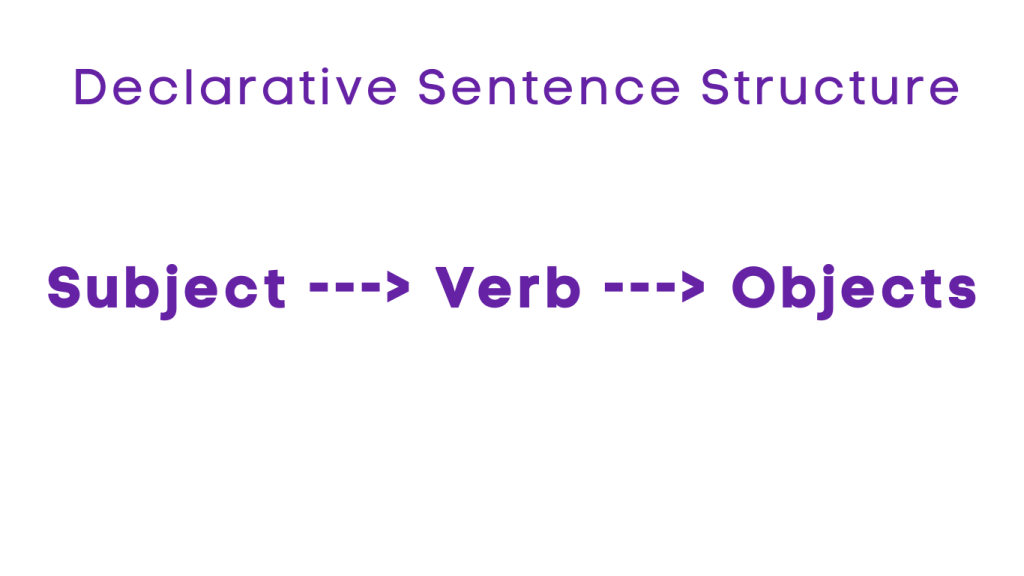Declarative Sentences – Meaning with Examples
Table of Contents
Introduction
Declarative Sentences
Declarative sentences are a fundamental part of language and communication. They are used to make statements, convey information, and express thoughts. In this article, we will explore the different types of declarative sentences, their structure, and the key differences between declarative and imperative sentences.
Analogy of Definition
What are Declarative Sentences?
A declarative sentence is a type of sentence that makes a statement or provides information. It ends with a period and is used to convey facts, opinions, or descriptions. Declarative sentences are the most common type of sentence in the English language. Declarative sentences can also be used to express feelings, intentions, or beliefs, making them versatile tools for communication in written and spoken language.
Method
Types of Declarative Sentences
There are several types of declarative sentences, including:
1. Simple Declarative Sentences
A simple declarative sentence consists of a single independent clause that makes a straightforward statement.
Example: She runs every morning.
2. Complex Declarative Sentences
A complex declarative sentence contains one independent clause and at least one dependent clause, often connected by subordinating conjunctions.
Example: When the sun rises in the east, it marks the beginning of a new day.
3. Compound Declarative Sentences
A compound declarative sentence consists of two or more independent clauses joined by coordinating conjunctions.
Examples: She runs every morning, and she also lifts weights in the evening.
4. Compound-Complex Declarative Sentences
A compound-complex declarative sentence contains two or more independent clauses and at least one dependent clause.
Examples: Although she enjoys reading books, she often visits the library, and she also loves watching movies, especially on weekends.
Structure of Declarative Sentences
A declarative sentence typically follows a subject-verb-object structure, where the subject performs the action described by the verb. It provides a complete thought and ends with a period.

Difference between Declarative and Imperative Sentences
Declarative sentences make statements or convey information, while imperative sentences give commands or instructions. Declarative sentences end with a period, while imperative sentences end with a period or an exclamation mark.
Purpose
Declarative Sentences: These sentences are used to make statements, convey information, or express opinions. They provide factual or subjective information without issuing commands.
Imperative Sentences: These sentences are used to give commands, instructions, or requests. They are intended to direct someone to do something or to achieve a certain action.
Structure
Declarative Sentences: Typically, declarative sentences follow a subject-verb-object structure or a subject-verb complement structure. They end with a period.
Imperative Sentences: Imperative sentences usually begin with a base verb (the imperative form), which may be followed by a subject (you) that is often implied. They can end with a period for neutral commands or with an exclamation mark for more forceful commands.
Tone
Declarative Sentences: The tone of declarative sentences is often neutral or informative, as they are primarily used to convey information or express opinions.
Imperative Sentences: The tone of imperative sentences is typically directive or commanding, as they are used to give orders or instructions to someone.
Subject
Declarative Sentences: Declarative sentences usually have a subject that performs the action described by the verb. The subject can be explicit or implicit.
Imperative Sentences: Imperative sentences may or may not explicitly state the subject. Often, the subject “you” is implied, especially in commands directed at the listener.
Examples
Declarative Sentence: “The sun sets in the west.”
Imperative Sentence: “Please close the door.”
In summary, declarative sentences provide information or make statements, while imperative sentences give commands or instructions. The structure, tone, and subject of each type of sentence differ accordingly.
Examples
1. Simple Declarative Sentence: “The sun is shining.”
2. Complex Declarative Sentence: “Although it was raining, the picnic went on as planned.”
3. Compound Declarative Sentence: “I wanted to go to the concert, but I had to work.”
4. Compound-Complex Declarative Sentence: “She studied hard because she wanted to pass the exam, and she succeeded.”
Quiz
Tips and Tricks
1. Use Active Voice
Tip: Write your sentences in active voice whenever possible to make them clearer and more direct. For example, instead of saying “The book was read by her,” say “She read the book.”
2. Keep It Concise
Tip: Try to express your ideas in a clear and concise manner. Avoid unnecessary words or phrases that don’t add meaning to the sentence.
3.Vary Sentence Structure
Tip: Experiment with different sentence structures to keep your writing interesting. This includes using simple, compound, complex, and compound-complex sentences.
4.Be Specific
Tip: Provide specific details and examples to support your statements. This adds depth to your writing and helps the reader understand your point of view.
5.Avoid Ambiguity
Tip: Make sure your sentences are clear and unambiguous. Double-check for any words or phrases that could be misinterpreted and clarify them if necessary.
Real life application
Scenario: “The Classroom Discussion”
In a classroom setting, teachers use declarative sentences to provide information, explain concepts, and share knowledge with students. For example, “The Earth revolves around the sun” is a declarative sentence used to convey scientific facts.
Scenario: “The Business Presentation”
During business presentations, professionals use declarative sentences to make statements, present data, and communicate key points. For instance, “Our company achieved a 20% increase in sales last quarter” is a declarative sentence used to convey business performance.
Scenario: “The News Report”
Journalists use declarative sentences to report facts, share news, and inform the public about current events. For example, “The stock market closed at an all-time high today” is a declarative sentence used in news reporting.
Scenario: “The Legal Brief”
Lawyers use declarative sentences to present arguments, state facts, and make assertions in legal documents. For instance, “The defendant’s alibi was confirmed by multiple witnesses” is a declarative sentence used in a legal brief.
Scenario: “The Scientific Research Paper”
Scientists use declarative sentences to describe findings, report results, and present conclusions in research papers. For example, “The experiment demonstrated a statistically significant effect” is a declarative sentence used in scientific writing.
FAQ's
Like? Share it with your friends

